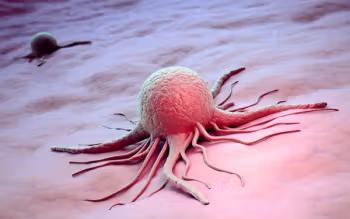
No Benefit to Postoperative Radiotherapy in Patients With Non-small Cell Lung Cancer
Key Takeaways
- PORT showed no significant improvement in 3-year DFS for NSCLC patients post-resection and chemotherapy.
- Mediastinal relapse rates decreased by 50% with PORT, but cardiopulmonary toxicity risks are a concern.
At ESMO 2020, researchers discussed some long-awaited data regarding postoperative radiotherapy used in patients with non-small cell lung cancer following complete resection and after (neo) adjuvant chemotherapy.
During a presentation at the ESMO Virtual Congress 2020, researchers discussed some long-awaited data regarding postoperative radiotherapy (PORT) used in patients with non-small cell lung cancer (NSCLC) following complete resection and after (neo) adjuvant chemotherapy. According to the findings, the researchers did not observe a statistically significant difference in 3-year disease-free survival (DFS).
Following the results of a meta-analysis from 1998 that cast doubt on the efficacy of PORT in completely resected NSCLC patients, the use of PORT in patients with mediastinal nodal involvement (pN2) has been a subject of debate.
Recently, results have demonstrated better selection, (neo)-adjuvant chemotherapy in stage III resected patients and improved radiotherapy, according to the authors of the current study. Additionally, non-prospective studies have suggested modern PORT may be able to improve patient outcomes.
For this reason, the researchers presenting at ESMO 2020 explained that they decided to investigate the role of modern mediastinal PORT further in a large, randomized trial to assess its use in adequately staged and surgically treated patients with completely resected NSCLC with histo/cytologically proven nodal involvement.
In the study, a total of 501 patients were included in the intention-to-treat analysis, of which 252 received PORT over 5 weeks, and 249 did not receive PORT in the control arm. The researchers also conducted a safety analysis that was carried out in 487 patients.
The results demonstrated that in the PORT arm, DFS was observed in 47.1% of patients, whereas in the control arm, DFS was observed in 43.8% of patients. The hazard ratio for these findings were 0.85 for patients receiving PORT compared with control.
In the PORT arm, the overall survival rate at 3 years was 66.5% compared with 68.5% in the control arm.
“PORT cannot be recommended for all patients with stage II and III NSCLC with mediastinal nodal involvement,” said study author Cécile Le Pechoux, MD, a radiation oncologist from Institut Gustave Roussy, Paris, France, in a press release. “Possibly, however, for some patients it might be useful because it does decrease the rate of mediastinal relapse by 50%. This must be put into balance with the risk of over-added cardio-pulmonary toxicity. We need to do further analysis to determine if certain patients, in particular, could benefit from it.”
Rafal Dziadziuszko, MD, PhD, a radiation oncologist from the Medical University of Gdansk, Poland, agreed that the results of the study help to support that the standard of care shouldn’t be to recommend radiotherapy to the mediastinum after surgery and after adjuvant chemotherapy.
“This will change the practice of many institutions that adopted standard use of radiotherapy in these patients,” Dziadziuszko said. “We can safely say there is no net benefit from such treatment but there is also potential harm, which we see from this study, so any potential benefits in some patients are offset by the predominantly higher risk of cardiopulmonary toxicities.”
REFERENCE
No Benefit for Post-operative Radiotherapy in Non-small-cell Lung Cancer. Lugano, Switzerland: ESMO 2020; September 20, 2020. esmo.org/meetings/esmo-virtual-congress-2020/meeting-resources/news/esmo2020-nsclc-port-lungart-radiotherapy-lung-cancer. Accessed September 25, 2020.
Newsletter
Stay informed on drug updates, treatment guidelines, and pharmacy practice trends—subscribe to Pharmacy Times for weekly clinical insights.























































































































































































































